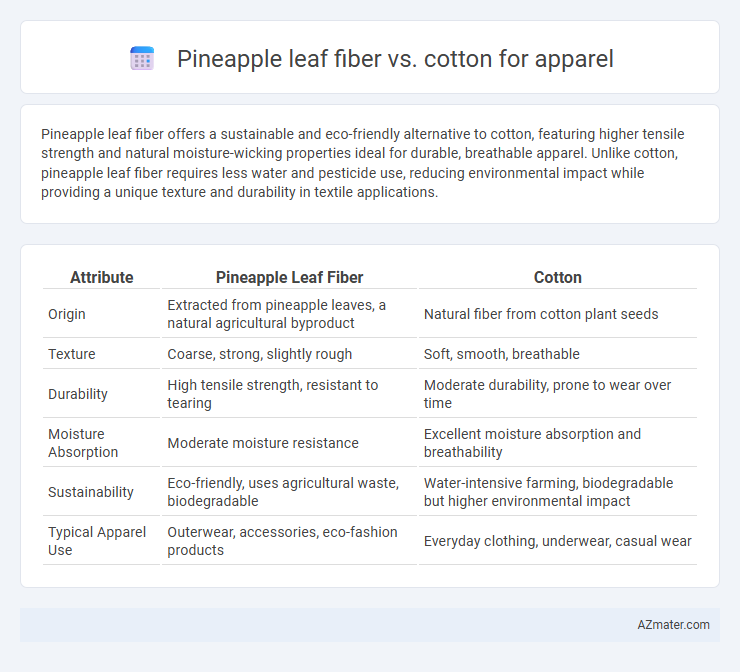Pineapple leaf fiber offers a sustainable and eco-friendly alternative to cotton, featuring higher tensile strength and natural moisture-wicking properties ideal for durable, breathable apparel. Unlike cotton, pineapple leaf fiber requires less water and pesticide use, reducing environmental impact while providing a unique texture and durability in textile applications.
Table of Comparison
| Attribute | Pineapple Leaf Fiber | Cotton |
|---|---|---|
| Origin | Extracted from pineapple leaves, a natural agricultural byproduct | Natural fiber from cotton plant seeds |
| Texture | Coarse, strong, slightly rough | Soft, smooth, breathable |
| Durability | High tensile strength, resistant to tearing | Moderate durability, prone to wear over time |
| Moisture Absorption | Moderate moisture resistance | Excellent moisture absorption and breathability |
| Sustainability | Eco-friendly, uses agricultural waste, biodegradable | Water-intensive farming, biodegradable but higher environmental impact |
| Typical Apparel Use | Outerwear, accessories, eco-fashion products | Everyday clothing, underwear, casual wear |
Introduction to Sustainable Fibers: Pineapple Leaf vs Cotton
Pineapple leaf fiber is an eco-friendly textile material derived from the waste leaves of pineapple plants, offering a sustainable alternative to conventional cotton. Cotton cultivation consumes vast amounts of water and pesticides, whereas pineapple leaf fiber production utilizes agricultural byproducts with minimal environmental impact. The growing demand for sustainable fibers in apparel drives innovation toward integrating pineapple leaf fiber for its durability, breathability, and lower carbon footprint compared to traditional cotton fabrics.
Overview of Pineapple Leaf Fiber Production
Pineapple leaf fiber is derived from the long leaves of the pineapple plant through a process involving extraction, washing, drying, and combing to separate fibers which are then spun into yarn. This sustainable fiber production utilizes agricultural waste, offering a biodegradable and eco-friendly alternative to conventional cotton. Unlike cotton cultivation, which requires extensive water and pesticides, pineapple leaf fiber production has a lower environmental footprint and supports circular fashion initiatives.
Cotton Fiber: Cultivation and Processing
Cotton fiber, derived from the seed hairs of the cotton plant, is cultivated predominantly in warm climates with well-drained soil, requiring extensive water and pesticide use during growth. The processing of cotton involves ginning to separate fibers from seeds, followed by cleaning, carding, and spinning to create soft, breathable textiles highly favored in apparel for comfort and durability. Compared to pineapple leaf fiber, cotton offers superior softness and elasticity, making it a preferred choice for everyday wear despite its higher environmental impact.
Environmental Impact: Pineapple Leaf Fiber vs Cotton
Pineapple leaf fiber, derived from agricultural waste, significantly reduces environmental impact by requiring minimal water, pesticides, and fertilizers compared to cotton cultivation, which is notoriously water-intensive and heavily reliant on chemical inputs. The biodegradability of pineapple leaf fiber and its ability to be sourced from by-products of pineapple farming contribute to lower carbon emissions and waste generation. Cotton farming accounts for approximately 24% of global insecticide use, making pineapple leaf fiber a more sustainable alternative in apparel production.
Textile Properties: Strength and Durability Comparison
Pineapple leaf fiber exhibits superior tensile strength and durability compared to cotton, making it highly suitable for long-lasting apparel. The natural toughness and rigidity of pineapple fibers provide enhanced resistance to wear and tear, while cotton's softness offers comfort but compromises durability under heavy use. Textile applications benefit from pineapple leaf fiber's moisture resistance and biodegradability, offering sustainable yet robust alternatives to traditional cotton fabrics.
Comfort and Breathability in Apparel
Pineapple leaf fiber offers superior moisture-wicking properties compared to cotton, enhancing breathability and keeping the wearer cooler in warm conditions. Cotton excels in softness and natural comfort, providing a gentle feel against the skin, whereas pineapple leaf fiber tends to be coarser but becomes softer with processing. Combining pineapple leaf fiber with cotton blends can optimize both comfort and breathability for sustainable and functional apparel.
Aesthetic Qualities: Texture, Dyeability, and Appearance
Pineapple leaf fiber offers a unique coarse texture with a natural sheen, providing an eco-friendly alternative to the soft, smooth surface of cotton widely favored for apparel. Its high cellulose content allows vibrant dye uptake, resulting in rich, long-lasting colors, whereas cotton's familiar dyeability yields a wide palette but may fade faster under frequent washing. Pineapple fiber garments typically exhibit a rustic, artisanal look contrasted with cotton's classic, uniform appearance, making each choice distinct in aesthetic appeal for sustainable fashion.
Cost and Market Accessibility
Pineapple leaf fiber offers a sustainable alternative to cotton with lower production costs due to minimal water and pesticide use, making it economically appealing in eco-conscious markets. Cotton remains dominant in the apparel industry because of its established supply chains and widespread market accessibility, despite higher water consumption and fluctuating prices. Emerging demand for eco-friendly fabrics is driving increased availability and competitive pricing for pineapple leaf fiber in niche fashion sectors.
Popularity and Adoption in Fashion Industry
Pineapple leaf fiber is gaining popularity in the fashion industry due to its sustainability and natural texture, offering a renewable alternative to traditional fabrics. Cotton remains the dominant choice in apparel production because of its softness, versatility, and established supply chains, but concerns over water usage and pesticide impact are driving interest towards pineapple leaf fiber. Adoption of pineapple fiber is increasing among eco-conscious brands seeking biodegradable materials, although cotton continues to lead in global market share.
Future Prospects: Innovations and Trends in Sustainable Fibers
Pineapple leaf fiber is emerging as a highly sustainable alternative to traditional cotton due to its renewable nature and minimal environmental footprint, requiring significantly less water and pesticides. Innovations in fiber processing now enhance pineapple leaf fiber's softness and durability, making it increasingly viable for high-quality apparel production. Trends indicate growing consumer demand and investment in bio-based textiles, positioning pineapple leaf fiber as a key player in the future of eco-friendly fashion.

Infographic: Pineapple leaf fiber vs Cotton for Apparel
 azmater.com
azmater.com